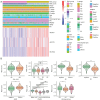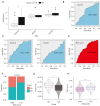Construction of a prognostic signature for breast cancer based on genes involved in unsaturated fatty acid biosynthesis
- PMID: 40104714
- PMCID: PMC11912055
- DOI: 10.21037/tcr-24-1668
Construction of a prognostic signature for breast cancer based on genes involved in unsaturated fatty acid biosynthesis
Abstract
Background: The biosynthesis of unsaturated fatty acids (UFAs) has been implicated in the onset and advancement of breast cancer (BC). This study aimed to develop molecular subtypes and prognostic signatures for BC based on UFA-related genes (UFAGs).
Methods: This study integrates multi-omics and survival data from public databases to elucidate molecular classifications and risk profiles based on UFAGs. Consensus clustering and Lasso Cox regression methodologies are employed for subtype identification and risk signature development, respectively. Immune microenvironment assessment is conducted using CIBERSORT and ESTIMATE algorithms, while drug sensitivity and response to immunotherapy are evaluated via pRRophetic and TIDE methods. Gene set enrichment analysis augments signature characterization, followed by nomogram construction and validation.
Results: We successfully identified two distinct BC molecular subtypes with significantly different prognoses utilizing UFAGs correlated with outcomes. A prognostic signature comprising three UFAGs [acetyl-CoA acyltransferase 1 (ACAA1), acyl-CoA thioesterase 2 (ACOT2), and ELOVL fatty acid elongase 2 (ELOVL2)] is developed, stratifying patients into high- and low-risk groups exhibiting divergent outcomes, clinicopathological traits, gene expression patterns, immune infiltration profiles, therapeutic susceptibility, and immunotherapy responses. The signature demonstrates robust prognostic performance in both training and validation cohorts, emerging as an independent predictor alongside age, which is integrated into a nomogram. Decision curve analysis highlights the nomogram's superiority over other factors in prognosis prediction. Calibration plots and receiver operating characteristic curves affirm its excellent performance in BC prognosis assessment.
Conclusions: Expression profiles of UFAGs are associated with BC prognosis, enabling the creation of a risk signature with implications for understanding the molecular mechanisms underlying BC progression.
Keywords: Unsaturated fatty acids (UFAs); breast cancer (BC); consensus clustering; immune microenvironment; nomogram.
Copyright © 2025 AME Publishing Company. All rights reserved.
Conflict of interest statement
Conflicts of Interest: All authors have completed the ICMJE uniform disclosure form (available at https://tcr.amegroups.com/article/view/10.21037/tcr-24-1668/coif). The authors have no conflicts of interest to declare.
Figures









Similar articles
-
Identification and validation of a dysregulated TME-related gene signature for predicting prognosis, and immunological properties in bladder cancer.Front Immunol. 2023 Oct 27;14:1213947. doi: 10.3389/fimmu.2023.1213947. eCollection 2023. Front Immunol. 2023. PMID: 37965307 Free PMC article.
-
Comprehensive FGFR3 alteration-related transcriptomic characterization is involved in immune infiltration and correlated with prognosis and immunotherapy response of bladder cancer.Front Immunol. 2022 Jul 26;13:931906. doi: 10.3389/fimmu.2022.931906. eCollection 2022. Front Immunol. 2022. PMID: 35958598 Free PMC article.
-
Integrative transcriptional characterization of cell cycle checkpoint genes promotes clinical management and precision medicine in bladder carcinoma.Front Oncol. 2022 Aug 11;12:915662. doi: 10.3389/fonc.2022.915662. eCollection 2022. Front Oncol. 2022. PMID: 36033441 Free PMC article.
-
PANoptosis-related molecular clustering and prognostic signature associated with the immune landscape and therapy response in breast cancer.Medicine (Baltimore). 2024 Sep 13;103(37):e39511. doi: 10.1097/MD.0000000000039511. Medicine (Baltimore). 2024. PMID: 39287311 Free PMC article.
-
Unfolded protein response signature unveils novel insights into breast cancer prognosis and tumor microenvironment.Cancer Genet. 2023 Aug;276-277:17-29. doi: 10.1016/j.cancergen.2023.06.001. Epub 2023 Jun 14. Cancer Genet. 2023. PMID: 37343507
References
LinkOut - more resources
Full Text Sources
